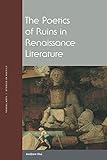The Poetics of Ruins in Renaissance Literature / Andrew Hui.
Material type: TextSeries: Verbal Arts: Studies in PoeticsPublisher: New York, NY : Fordham University Press, [2017]Copyright date: ©2017Description: 1 online resource (296 p.)Content type:
TextSeries: Verbal Arts: Studies in PoeticsPublisher: New York, NY : Fordham University Press, [2017]Copyright date: ©2017Description: 1 online resource (296 p.)Content type: - 9780823273355
- 9780823273379
- 809.02
- online - DeGruyter
- Issued also in print.
| Item type | Current library | Call number | URL | Status | Notes | Barcode | |
|---|---|---|---|---|---|---|---|
 eBook
eBook
|
Biblioteca "Angelicum" Pont. Univ. S.Tommaso d'Aquino Nuvola online | online - DeGruyter (Browse shelf(Opens below)) | Online access | Not for loan (Accesso limitato) | Accesso per gli utenti autorizzati / Access for authorized users | (dgr)9780823273379 |
Frontmatter -- Contents -- Figures and Color Plates -- Introduction. A Japanese Friend -- Part I -- Chapter 1. The Rebirth of Poetics -- Chapter 2. The Rebirth of Ruins -- Part II -- Chapter 3. Petrarch's Vestigia and the Presence of Absence -- Chapter 4. The Hypnerotomachia Poliphili and the Erotics of Fragments -- Chapter 5. Du Bellay's Cendre and the Formless Signifier -- Chapter 6. Spenser's Moniment and the Allegory of Ruins -- Epilogue. Fallen Castles and Summer Grass -- Acknowledgments -- Notes -- Index
restricted access online access with authorization star
http://purl.org/coar/access_right/c_16ec
The Renaissance was the Ruin-naissance, the birth of the ruin as a distinct category of cultural discourse, one that inspired voluminous poetic production. For humanists, the ruin became the material sign that marked the rupture between themselves and classical antiquity. In the first full-length book to document this cultural phenomenon, Andrew Hui explains how the invention of the ruin propelled poets into creating works that were self-aware of their absorption of the past as well as their own survival in the future.
Issued also in print.
Mode of access: Internet via World Wide Web.
In English.
Description based on online resource; title from PDF title page (publisher's Web site, viewed 02. Mrz 2022)


